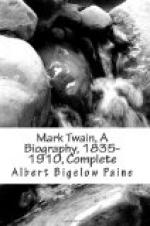LXIX
A LECTURE TOUR
James Redpath, proprietor of the Boston Lyceum Bureau, was the leading lecture agent of those days, and controlled all, or nearly all, of the platform celebrities. Mark Twain’s success at the Cooper Union the year before had interested Redpath. He had offered engagements then and later, but Clemens had not been free for the regular circuit. Now there was no longer a reason for postponement of a contract. Redpath was eager for the new celebrity, and Clemens closed with him for the season of 1868-9. With his new lecture, “The Vandal Abroad,” he was presently earning a hundred dollars and more a night, and making most of the nights count.
This was affluence indeed. He had become suddenly a person of substance-an associate of men of consequence, with a commensurate income. He could help his mother lavishly now, and he did.
His new lecture was immensely popular. It was a resume of the ’Quaker City’ letters—a foretaste of the book which would presently follow. Wherever he went, he was hailed with eager greetings. He caught such drifting exclamations as, “There he is! There goes Mark Twain!” People came out on the street to see him pass. That marvelous miracle which we variously call “notoriety,” “popularity,” “fame,” had come to him. In his notebook he wrote, “Fame is a vapor, popularity an accident; the only, earthly certainty oblivion.”
The newspapers were filled with enthusiasm both as to his matter and method. His delivery was described as a “long, monotonous drawl, with the fun invariably coming in at the end of a sentence—after a pause.” His appearance at this time is thus set down:
Mark Twain is a man of medium height, about five feet ten, sparsely built, with dark reddish-brown hair and mustache. His features are fair, his eyes keen and twinkling. He dresses in scrupulous evening attire. In lecturing he hangs about the desk, leaning on it or flirting around the corners of it, then marching and countermarching in the rear of it. He seldom casts a glance at his manuscript.
No doubt this fairly presents Mark Twain, the lecturer of that day. It was a new figure on the platform, a man with a new method. As to his manuscript, the item might have said that he never consulted it at all. He learned his lecture; what he consulted was merely a series of hieroglyphics, a set of crude pictures drawn by himself, suggestive of the subject-matter underneath new head. Certain columns represented the Parthenon; the Sphinx meant Egypt, and so on. His manuscript lay there in case of accident, but the accident did not happen.
A number of his engagements were in the central part of New York, at points not far distant from Elmira. He had a standing invitation to visit the Langdon home, and he made it convenient to avail himself of that happiness.




